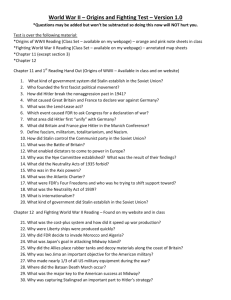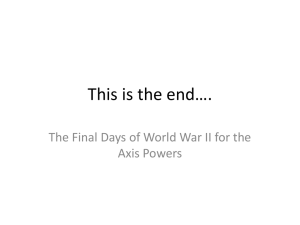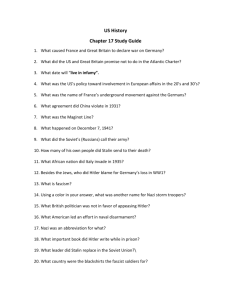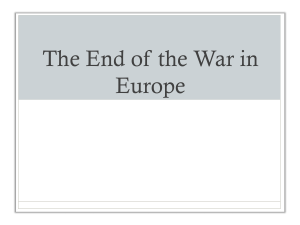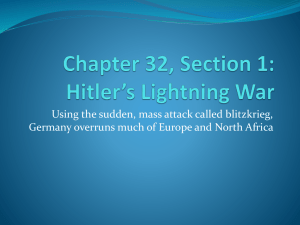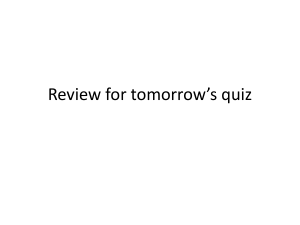WWII Ppt Notes
advertisement
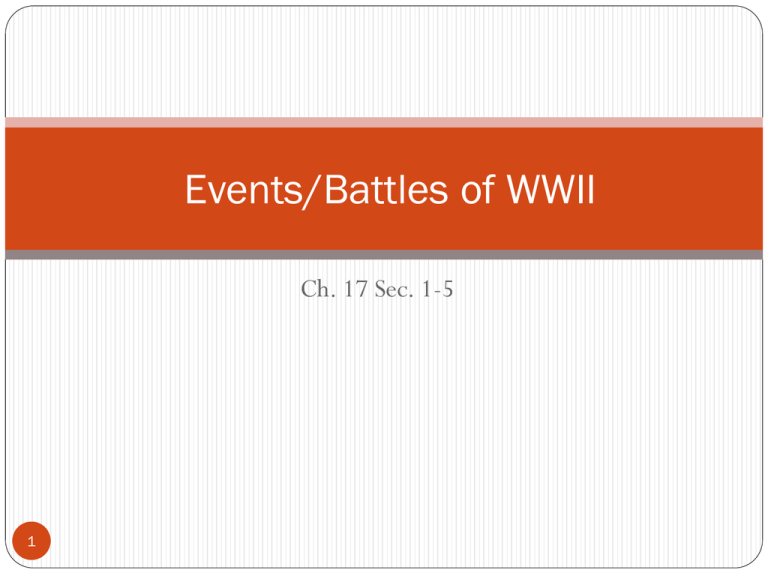
Events/Battles of WWII Ch. 17 Sec. 1-5 1 From Appeasement to War Ch. 17 Sec. 1 2 Aggression Goes Unchecked Aggressive actions by Germany, Japan and Italy were met with verbal protests Hitler, leaders of Japan, and Mussolini saw desire for peace as a weakness 1. Japan overruns Manchuria and Eastern China 2. Italy Invades Ethiopia 3. Hitler went against Treaty of Versailles1. 2. 3. Built up German military Sent troops in “demilitarized” Rhineland Quit paying WWI reparations • All these actions were met with appeasement 3 Rome-Berlin-Tokyo Axis Agreed to fight Soviet Communism Agreed to not interfere with one another’s plans for territorial expansion Set the path for these anti-democratic aggressor powers to take bolder steps 4 Spain Collapses into Civil War Starting in 1931 unrest boiled over polarized public opinion over setting up a republic after forcing the king to abdicate 1936 Francisco Franco led a revolt that started the civil war Other nations soon jumped in to support both sides Soviet Union, anti-Nazi Germans, and anti-Fascist Italians joined Spanish Loyalist US, Britain, and France remained neutral Hitler used his modern warfare to help Franco take power Once in power- Franco set up a Fascist dictatorship similar to Hitler and Mussolini 5 Continued German Aggression One of Hitler’s goals- bring all German people into the Third Reich Took steps to gain more “living space” for Germans Annexed Austria 1. • • • • Annexed Sudetenland 2. • • 6 1938 Ready to engineer the Anschluss Violated Treaty of Versailles Some Austrians favored Annexation Western democracies took no action 3 mill Germans lived in Sudetenland Western democracies did nothing “Peace for Our Time” 1938: Munich Conference British and French leaders chose to appease Hitler Gave Hitler Sudetenland Hitler assured Britain/France he had no further plans of expansion “Peace for Our Time” – Chamberlain thought he had fixed the problems of Europe Winston Churchill- “They choose between war and dishonor. They chose dishonor; they will have a war.” 7 Europe Plunges Toward War March 1939: Hitler broke promise- took over rest of Czechoslovakia Realized appeasement would not work- promised to protect Poland August 1939: Nazi-Soviet Pact Hitler announced a non-aggression pact with enemy- Joseph Stalin Based not on friendship but mutual need- Hitler feared communism as Stalin feared Fascism Each man felt he was protecting his country September 1, 1939: Germany invaded Poland Two days later Britain and France declared war on Germany 8 The Axis Advances Ch. 17 Sec. 2 9 Axis Powers Attack Sept. 1, 1939: Nazi forces stormed into Poland from the West Stalin’s forces invaded from the East Within 1 month, Poland surrendered Britain and France declared war on 10 Germany Soviet Union set up military bases in Estonia, Latvia, and Lithuania and seized part of Finland Miracle at Dunkirk April 1940: Hitler launched Blitzkrieg against Norway and Denmark Next he took Netherlands and Belgium May 1940: German forces surprised French and British by attacking through Ardennes Forest (Belgium) Trapped between Nazi army and English Strait English sent any available vassal to pick up troops Saved more than 300,000 troops to Britain 11 12 13 14 France Falls Germans headed South to Paris Italians declared war on France and attacked from the south June 22, 1940: France signed surrender papers in same train car Germany signed armistice to end WWI Some French escaped to Britain to set up a Government in Exile under Charles de Gaulle 15 They worked to liberate their homeland 16 17 18 Operation Sea Lion Winston Churchill replaced Neville Chamberlain as Prime Minister Hitler made plans for Operation Sea Lioninvasion of Britain August 1940: Germany began daily bombing of southern coast of Britain After a month, Germany began bombing London instead of military in south Citizens carried on with everyday life- did not let 19 Germans see them sweat 20 21 Sea Lion, Africa, and Balkans May 1941: Operation Sea Lion deemed a failure Germans could not get air superiority over Britain British morale remained high Sept. 1940: Axis Armies moved in to North Africa and Balkans Italy’s colony in Libya attacked Egypt- British resisted Hitler sent General Erwin Rommel “Desert Fox” who pushed British back to Cairo, Egypt Oct. 1940: Italians invaded Greece- needed German reinforcements by 1941 22 1941: Axis Powers held most of Europe 23 Germany Invades the Soviet Union Hitler turned forces from failure to take Britain to invade Soviet Union One of his costliest mistakes June 1941: Hitler nullified Nazi-Soviet Pact- Operation Barbarossa (named after Frederick Barbarossa) About 3 million German soldiers invaded- caught Stalin unprepared Stalled at Leningrad (St. Petersburg)- 2 ½ year battle Britain opened a second front to relieve Stalin Hitler failed to take Leningrad 24 25 Japan attacks US US sympathizers found ways around Neutrality Acts to help British when they stood alone March 1941: FDR and Congress passed Lend-Lease Act Aug. 1941: Roosevelt signed Atlantic Charter with Churchill Japan was frustrated at US’s Neutrality Acts because if affected their progress into French Indochina and Dutch East Indies 26 With talks at a standstill, Gen. Tojo 27 ordered an attack on US Dec. 7, 1941: Japanese planes bombed American fleet at Pearl Harbor, Hawaii US declared war on Japan Dec. 11, 1941: Germany and Italy declared war on US as Japans allies Japanese initially successful capturing Philippines and other US islands and British lands 28 29 30 The Allies Turn the Tide Ch. 17 Sec. 3 31 Allies Turn to Total War Governments increase political power Factories started making war products Programs to ration food Raised money with War Bonds drives Production ended unemployment from depression Government limited rights of citizens, censored the press, used propaganda to win public support Women replaced men in the factories and helped 32 in war efforts 33 34 Allies Forge Ahead 1942-1943 Turning point in the war Allies win victories on four fronts- Pacific, North Africa and Italy, Soviet Union, and France Pacific- Battle of Coral Sea- First set back for Japanese Enemy ships never even saw each other: battle fought by plane from aircraft carriers Continued wins at Battle of Midway Japan was unable to launch any more offensive attacks 35 Battle of Midway 36 37 38 Big Three Plot their Strategy “Big Three” (US, Britain, France) agreed to 39 focus on finishing the war in Europe before ending the war in Asia Churchill and Roosevelt feared Stalin wanted to dominate Europe/ Stalin believed West wanted to end communism Nazi-Soviet Pact borders stood Churchill/Roosevelt would not open a second front against Germany to relieve Soviet Union troops Allied Victory in North Africa British led by General Bernard 40 Montgomery fought “Desert Fox” Rommel Nov. 1942: Battle of El Alamein- Allies halted Axis advances and drove them back to Libya and Tunisia May 1943, General Dwight Eisenhower advanced into Tunisia and forced Rommel to surrender 41 Allies Advance through Italy Allies from North crossed to Mediterranean into Italy American/ British troops landed first in Sicily and then southern Italy Defeated Italian forces within a month Italians overthrew Mussolini and signed armistice Hitler sent troops to aid northern Italy and 42 rescue Mussolini Allies fought next 18 months to take the north- helped to weaken German army 43 Germans Defeated at Stalingrad German troops stalled outside Leningrad 1941 1942 Hitler launched new offensive- aimed for the rich oil fields of the south Only made it to Stalingrad One of the costliest battles of the war Hitler and Stalin both determined Nov. 1942: Soviets encircled their attackers and cutoff supply lines Jan. 1943: German commander surrendered By early 1944: Soviet troops advancing to East 44 Europe 45 46 47 Allies Push Towards Germany June 6, 1944: D-Day Paratroopers dropped in night before At dawn, thousands crossed English Channel under fire towards Normandy Aug. Gen. Patten helped Brit./Amer. Troops break through German forces towards Paris Other Allied forces sailed in from Italy French resistance rose in Paris to help Aug. 25, 1944 Allied troops entered Paris Rest of France was free within a month 48 49 50 51 52 53 54 Allies Continue to Advance Allied forces entered Belgium as Germany launched a massive counterattack Battle of the Bulge- lasted more than a month Both sides took terrible losses Germans could not break through/ delayed the Allied advance from the West Soviet Union battled through Germany and 55 advanced on Berlin from the East Hitler’s support was in decline By 1945 defeat of Germany seemed inevitable 56 Agreement at Yalta Feb. 1945: Big Three planned strategy in atmosphere of distrust Stalin wanted to maintain control of East to protect Soviet Union in the future Churchill/Roosevelt wanted self-determination of East Agreed: Soviet Union would enter war against Japan 3 months after fall of Germany- in return Stalin would keep possession of Southern Sakhalin Island, Kuril Islands, & part of Korea Germany would be divided into 4 zonesUS/Fr/Br/SU- free elections in all zones 57 58 Victory in Europe and the Pacific Ch. 17 Sec. 4 59 Nazi’s Defeat March 1945: Allies crossed Rhine from 60 West, Soviets closed in on Berlin from Eastmet and shook hands at the Elbe River In Italy- Guerrillas captured/executed Mussolini Hitler committed suicide May 7, 1945: Germany surrendered May 8, 1945: War officially ended in Europe (V-E Day: Victory in Europe) 61 Successes for the Allies Location of Germany forced it to fight on multiple fronts Hitler held sole power of decision making and made some poor choices Hitler underestimated Soviets’ armies US productivity doubled all Axis powers combined Allied bombing hindered German production Oil became scarce grounding the Luftwaffe 62 Struggle for the Pacific After battles of Midway & Coral Sea- Americans 63 took the offensive Summer 1942: US Marines landed at Guadalcanal- Victory at Guadalcanal marking beginning of “Island Hopping” campaign Recapture some islands while bypassing others Led by Gen. Douglas MacArther By 1944: US Navy led by Admiral Chester Nimits blockaded Japan with US bombers pounding cities and industries British fought Japanese in Burma and Malaysia Defeat of Japan Mid-1945 most of Japanese Navy and Air Force 64 had been destroyed With V-E Day Allies poured all resources into fighting Japan Feb. – March 1945: Battle of Iwo Jima April-July 1945: Battle of Okinawa 1944: Started Kamikaze missions Manhattan Project offered a solution to end the war July 1945: 1st Atom bomb successfully tested 65 66 67 Kamikaze plane sliced through US ship during Okinawa 68 Ending the War President Truman (Took office April 12, 1945) 69 decided Atom bomb would save American lives and to use the weapon against Japan US warned Japanese officials of “complete destruction” & “utter devastation” Aug. 6, 1945: Enola Gay dropped “Little Boy” on Hiroshima Aug. 8, 1945: Soviets declared war on Manchuria Ending the War Con’t Aug. 9, 1945: Laggin Dragon dropped Fat Man on Nagasaki Aug. 10, 1945: Emperor Hirohito intervened and surrendered Sept. 2, 1945: Formal treaty signed on US Missouri in Tokyo Bay 70 71 72 73 74 75 The energy released by the bomb was powerful enough to burn through clothing. The dark portions of the garments this victim wore at the time of the blast were emblazoned on to the flesh as scars, while skin underneath the lighter parts (which absorb less energy) was not damaged as badly.[ 76 77 78 79 80 The End of WWII Ch. 17 Sec. 5 81 War’s Aftermath Over 50 million dead/30 mill Europeans/ 20 mill. Russians Dealing with horrors of the Holocaust Allies were aware but did not know the extent until the war’s end War Crime Trials in Nuremburg Axis leaders tried for “crimes against humanity” Nearly 200 German/Austrians found guilty Showed military leaders could be held accountable for actions in wartime 82 Nuremburg Trials 83 84 Establishing the United Nations April 1945 delegates from 50 nations met to draft the charter from the UN Each member country had one vote in the general council Security Council can veto and decision by the general council The US, SU (Russia), GB, FR, Ch were permanent members of the Security Council Dealt with World problems, not just peacekeeping 85 86 87 Alliance Break Apart Germany defeated France and Britain exhausted US and Soviet Union emerge as new world leaders Conflicting ideologies and mutual distrust led to the Cold War 88 Cold War Stalin’s troops occupied Eastern Europe He wanted to spread Communism to those areas US/Britain occupied Japan and Italy They had set up democratic governments, power of the people US/Britain made Stalin promise free elections in Eastern Europe – Stalin ignored this pledge By 1948, pro-Soviet communist governments were in place throughout Eastern Europe 89 New Conflicts Develop Truman Doctrine: “I believe that it must be the policy of the United States to support free peoples who are resisting attempted subjugation by armed minorities or by outside pressures.” 90 Marshall Plan Western Europe was fertile ground for communist ideas US funneled food and economic assistance into Europe to strengthen democratic governments We even attempted to help Stalin and Eastern European nations- which he declined 91 A Divided Germany France, Britain, US wanted to rebuild Germany and make a 92 democratic nation Soviet Union opposed the idea FR, GB, US combined their lands and extended the Marshall Plan to Western Europe Western Germany was allowed to write their own constitution and regain self-government Tensions continued further into the Cold War 93 94

